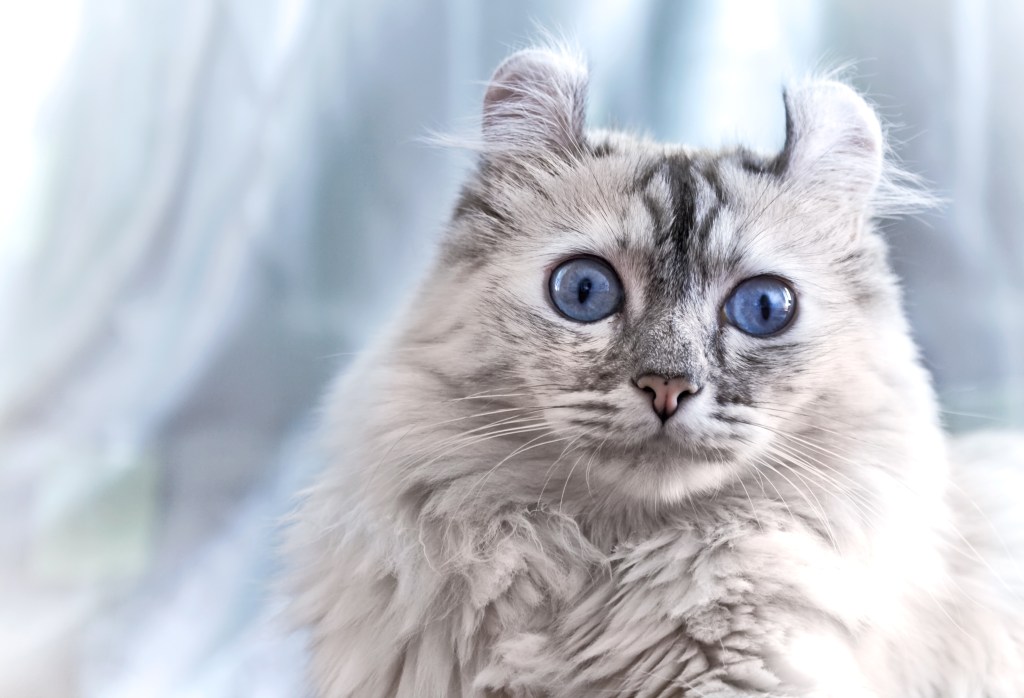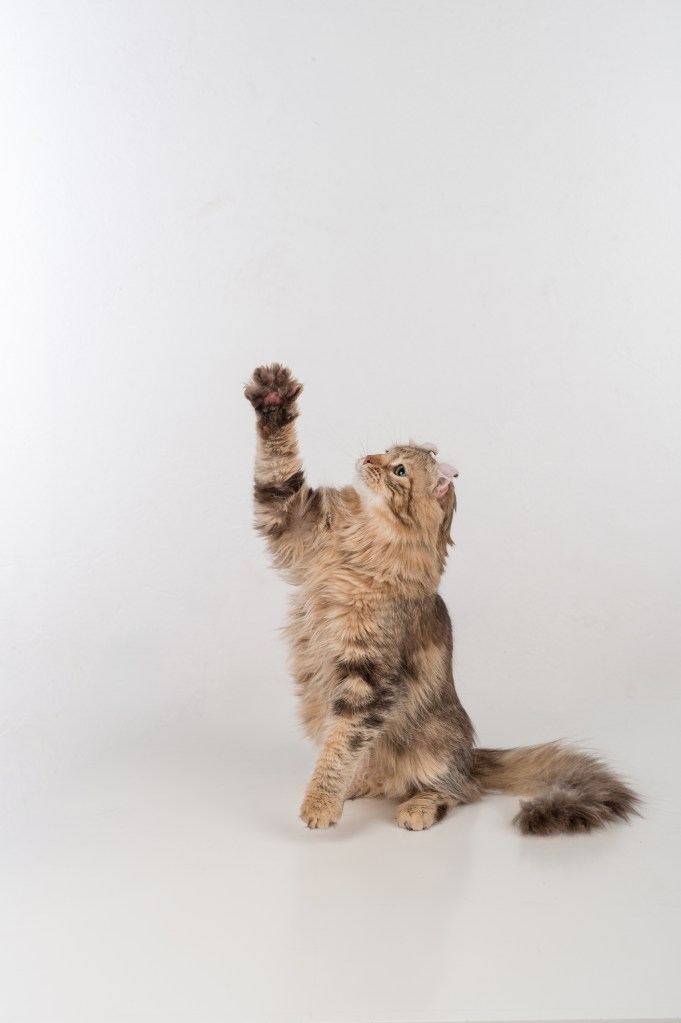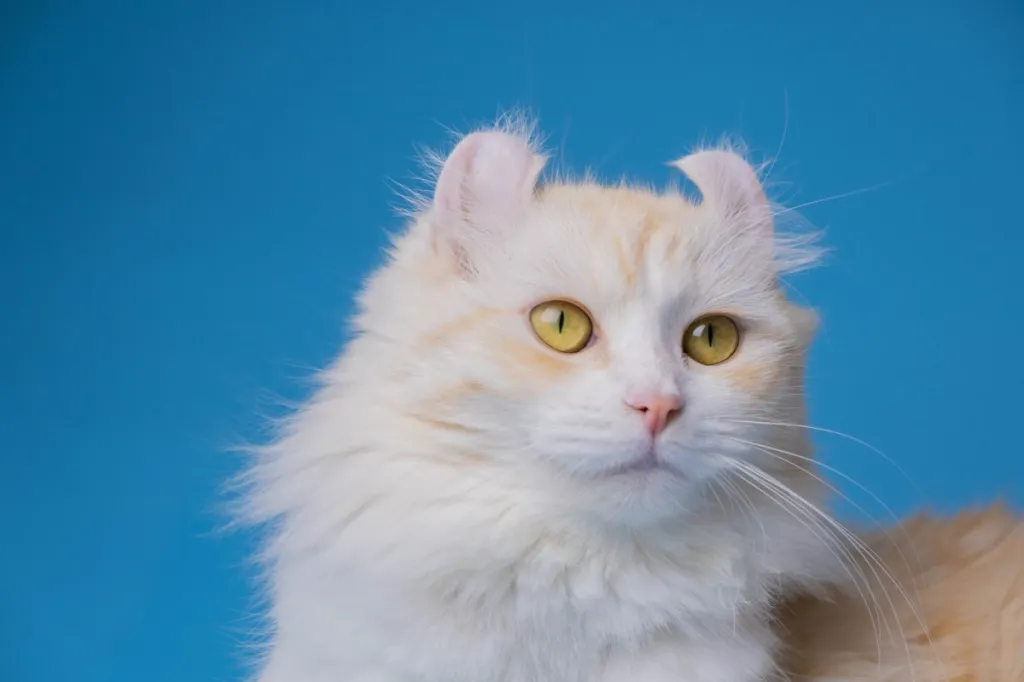The American Curl is a distinctive and charming cat breed known for its unique curled ears, which curl backward in an elegant arc, giving the breed its name. This distinctive feature is a result of a genetic mutation affecting the cartilage in the ear, and the degree of curl can vary among individual cats. Apart from their captivating ears, American Curls have a medium-sized, well-muscled body with a silky, semi-longhaired coat that comes in a variety of colors and patterns.
Known for their friendly and sociable nature, American Curls make excellent companions. They are affectionate, adaptable, and enjoy interacting with their human family members. Additionally, this breed is generally good with children and other pets. They make excellent additions for families and multi-pet households seeking a loving feline companion. With their playful and curious personalities, American Curls often engage in interactive play and enjoy perching on their owner’s shoulder to observe the world around them.
When considering an American Curl, it’s advisable to prioritize adopting from rescue organizations or shelters to provide a loving home to a cat in need. However, if you decide to purchase an American Curl kitten, it’s crucial to choose a reputable breeder. Conduct thorough research to ensure that the breeder follows ethical practices and prioritizes the well-being of their cats. Reputable American Curl breeders prioritize the health and temperament of their cats, conduct necessary health screenings, and provide a nurturing environment for the kitties. This active approach ensures that you bring home a healthy and happy kitty while discouraging unethical breeding practices.
Quick Facts
- Origin: United States
- Size: Medium
- Breed Group: Shorthair and Longhair
- Lifespan: 9-13 years
- Coat: Short or long, silky, and fine, with a variety of colors and patterns
- Temperament: Friendly, playful, and affectionate
- Exercise Needs: Moderate
- Training: Easy to train
- Grooming: Weekly brushing for short-haired cats and regular brushing for long-haired cats
- Health: Generally healthy, but can be prone to certain genetic health conditions, such as hypertrophic cardiomyopathy (HCM)
- The curl in their ears starts to develop when they are about a week old and is fully formed by the time they are 5 months old. Throughout that time, they will curl and uncurl.
- Kittens in an American Curl litter can have straight or curled ears!
- These are not the only cats with curled ears. Fold cats also have curled ears, but they are curled forward rather than backward.
American Curl Pictures






-
Affectionate with Family
Some cat breeds are typically independent and aloof, even if they’ve been raised by the same person since kittenhood; others bond closely to one person and are indifferent to everyone else; and some shower the whole family with affection. Breed isn’t the only factor that goes into affection levels; cats who were raised inside a home with people around feel more comfortable with humans and bond more easily.

See Cats Less Affectionate with Family -
Amount of Shedding
If you’re going to share your home with a cat, you’ll need to deal with some level of cat hair on your clothes and in your house. However, shedding does vary among the breeds. If you’re a neatnik, you’ll need to either pick a low-shedding breed or relax your standards. This furniture cover can make it easier to clean up cat hair and keep it off your sofa!
-
General Health
Due to poor breeding practices, some breeds are prone to certain genetic health problems. This doesn’t mean that every cat of that breed will develop those diseases; it just means that they’re at an increased risk. If you’re looking only for purebred cats or kittens, it’s a good idea to find out which genetic illnesses are common to the breed you’re interested in.
-
Potential for Playfulness
Some cats are perpetual kittens—full of energy and mischief—while others are more serious and sedate. Although a playful kitten sounds endearing, consider how many games of chase the mouse-toy you want to play each day, and whether you have kids or other animals who can stand in as playmates. A classic wand cat toy like this one is perfect for playful felines!
-
Tendency to Vocalize
Some breeds sound off more often than others with meows, yowls, and chattering. When choosing a breed, think about how the cat vocalizes and how often. If constant “conversation” drives you crazy, consider a kitty less likely to chat.
-
Kid-Friendly
Being tolerant of children, sturdy enough to handle the heavy-handed pets and hugs they can dish out, and having a nonchalant attitude toward running, screaming youngsters are all traits that make a kid-friendly cat. Our ratings are generalizations, and they’re not a guarantee of how any breed or individual cat will behave; cats from any breed can be good with children based on their past experiences and personality.
-
Friendly Toward Strangers
Stranger-friendly cats will greet guests with a curious glance or a playful approach; others are shy or indifferent, perhaps even hiding under furniture or skedaddling to another room. However, no matter what the breed, a cat who was exposed to lots of different types, ages, sizes, and shapes of people as a kitten will respond better to strangers as an adult.
-
Easy to Groom
Some breeds require very little in the way of grooming; others require regular brushing to stay clean and healthy. Consider whether you have the time and patience for a cat who needs daily brushing. You should definitely pick up this awesome de-shedding tool for cats of any hair length!
-
Pet Friendly
Friendliness toward other household animals and friendliness toward humans are two completely different things. Some cats are more likely than others to be accepting of other pets in the home.
American Curl History
The American Curl is one of the youngest cat breeds. It was born of a natural genetic mutation that first appeared in Shulamith, a stray black kitten with long, silky hair and, strangely, ears that curled backward. She found her way to the welcoming door of Joe and Grace Ruga in Lakewood, California. The Rugas named her Shulamith after the “black and comely” princess in the Old Testament book the Song of Solomon.
Shulamith had a litter of four kittens by an unknown father, and two of them shared her curly ears. A consultation with a geneticist showed that the trait was caused by a dominant gene. Cat fanciers began selectively breeding the cats in 1983, and the new breed, named the American Curl, began to be registered by the Cat Fanciers Association in 1986. They were recognized by The International Cat Association in 1987 and achieved full recognition from CFA in 1993.
With almost unheard-of rapidity, the trip from stray to pedigreed breed took only six years. The breed also stands out for being the first single breed with two coat lengths recognized by CFA. All American Curls are descended from Shulamith. The cats can be bred to other Curls or outcrossed to non-pedigreed domestic cats with straight ears that otherwise meet the Curl breed standard. This helps to ensure a large gene pool and genetic diversity. Straight-eared kittens from American Curl litters can be used in breeding programs or placed as pets.
American Curl Size
The American Curl is a medium-size cat, weighing 5 to 10 pounds.
American Curl Personality
The friendly and gentle American Curl is known for his people-loving personality. He even likes children, which is not always the case with cats, and has been known to seek out their company. True to to his domestic shorthair heritage, he is moderately active, curious and smart. He is likely to follow you around to see what you’re doing, but he’s not talkative or bossy like some breeds. If need be, he will quietly petition you for attention, food or whatever else he wants.
When you come home from work, he will gladly greet you with a head bump and may even extend the affectionate gesture to guests in the home. American Curls are often called the “Peter Pan” of the cat world. It is not unusual to see older Curls flying through the house with just as much joy as younger ones.
Males and females are equally active. The Curl likes to play and can learn to fetch. He’s also capable of opening doorknobs, so be careful what you put away in any cabinets that are within his reach. When he’s ready for a break, he will happily settle into a lap. He is alert and adaptable, well suited to any home or family who will love him.
American Curl Health
Both pedigreed cats and mixed-breed cats have varying incidences of health problems that may be genetic in nature. American Curls are generally healthy, but some lines have problems wit:
- Narrow Ear Canals: This can lead to ear infections from wax buildup. Narrow ear canals in cats can be a congenital (present at birth) condition or may develop as a result of certain factors. The ear canal is the passage leading from the external ear to the eardrum, and its size and shape can vary among individual cats.
American Curl Care
The Curl’s coat can be short or long, and both lengths are easy to care for. The longhaired variety has little undercoat, so it’s unlikely to mat or tangle. A weekly combing is plenty to keep the longhaired or shorthaired Curl looking beautiful. Try running the comb backwards through the shorthair’s coat; it can help to remove any dead hair that has accumulated.
Shorthairs shed year-round and tend to shed more than the longhairs. During warm months, when the longhairs may shed more heavily, it’s a good idea to brush or comb more often. A bath is rarely necessary.
Brush the teeth to prevent periodontal disease. Daily dental hygiene is best, but weekly brushing is better than nothing. Trim the nails every couple of weeks. Wipe the corners of the eyes with a soft, damp cloth to remove any discharge. Use a separate area of the cloth for each eye so you don’t run the risk of spreading any infection.
Check the ears weekly. If they look dirty, wipe them out with a cotton ball or soft damp cloth moistened with a 50-50 mixture of cider vinegar and warm water. Avoid using cotton swabs, which can damage the interior of the ear. Handle the ears carefully; you don’t want to break the cartilage.
Keep the American Curl’s litter box spotlessly clean. Cats are very particular about bathroom hygiene. It’s a good idea to keep a American Curl as an indoor-only cat to protect him from diseases spread by other cats, attacks by dogs or coyotes, and the other dangers that face cats who go outdoors, such as being hit by a car. American Curl who go outdoors also run the risk of being stolen by someone who would like to have such a beautiful cat without paying for it.
American Curl Coat Color And Grooming
The Curl stands out for his distinctively shaped ears, but even without them he is a striking cat with a sweet expression, and a silky coat that can be long or short and any color, including such exotic shades as chocolate tortoiseshell smoke, silver patched tabby and lilac lynx point. The longhaired variety has a pretty plumed tail. The ears, however, are the most intriguing characteristic.
Straight when a kitten is born, they begin to curl back at two to 10 days after birth. They curl, uncurl and curl some more until reaching their permanent shape when a kitten is about 4 months old. A kitten destined for the show ring will have a crescent-shaped ear with a minimum 90 degree arc of curl but no more than 180 degrees. The tips of the moderately large ear are rounded and flexible, often adorned with tufts of fur. When Curls are alert, their ears swivel forward, but the tips point to the center of the base of the skull.
Children And Other Pets
The Curl is sweet toward children, making him a good choice for families who will supervise children to make sure they pet the cat nicely and don’t pull his ears or tail. He is happy to live with cat-friendly dogs, too, thanks to his amiable disposition. Introduce pets slowly and in controlled circumstances to ensure that they learn to get along together.
American Curl Rescue Groups
More Info For You
If you’re also looking for a dog, check out DogTime’s dog breed page!





